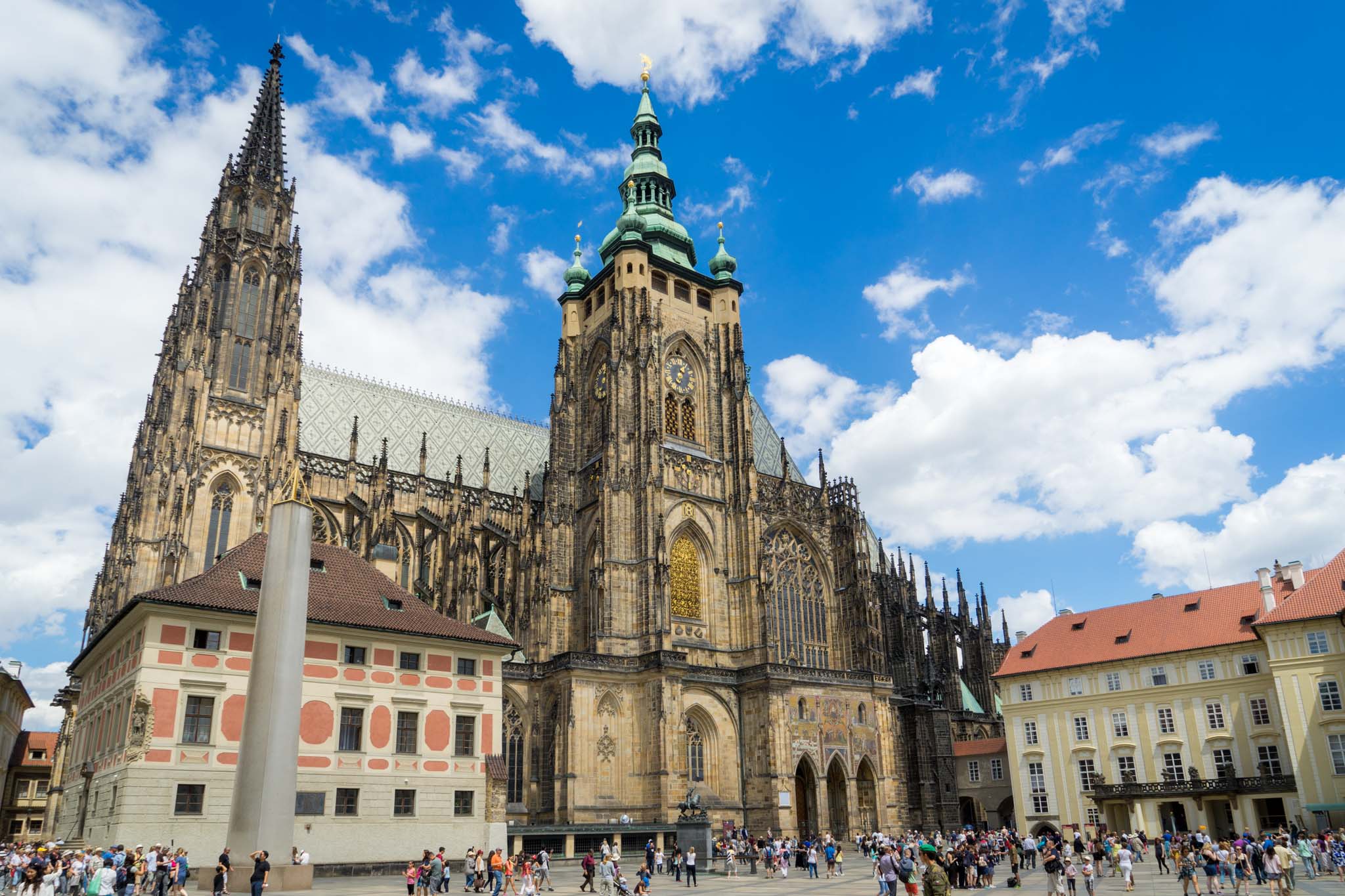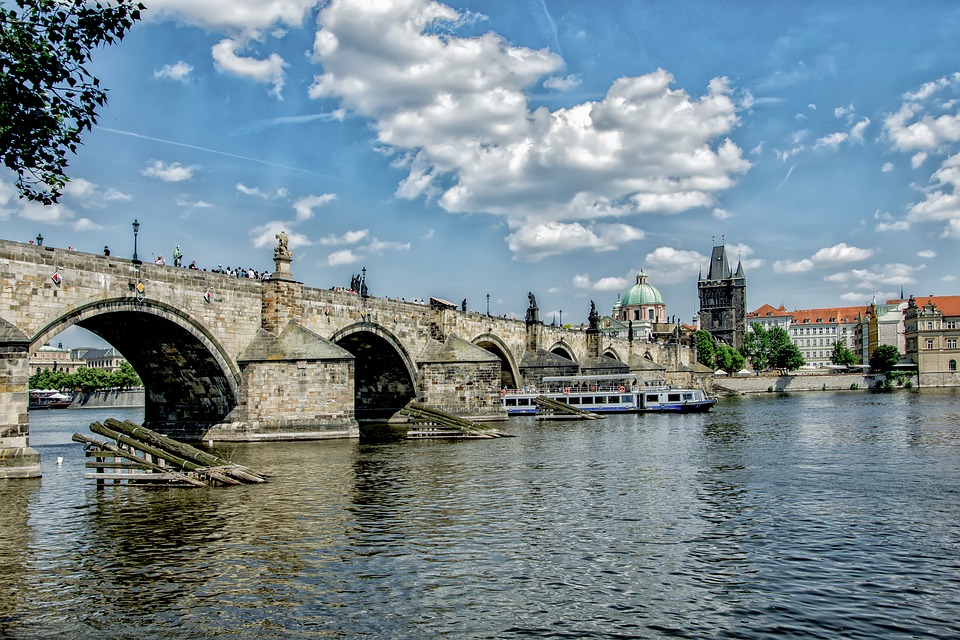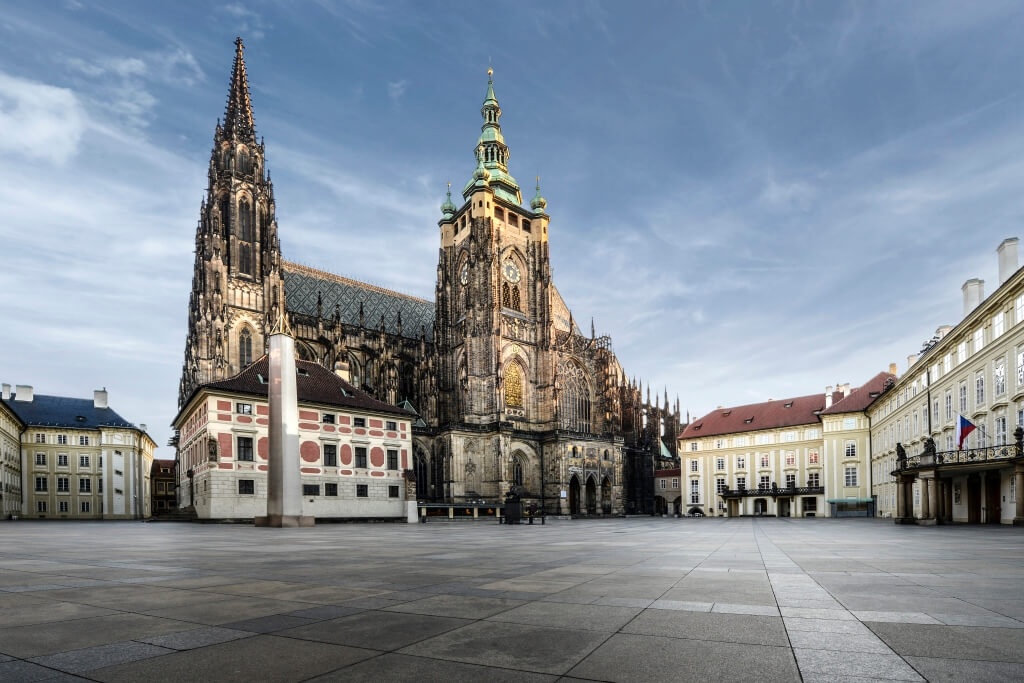St Vitus Cathedral
Built over a time span of almost 600 years, St Vitus is one of the most richly endowed cathedrals in central Europe. It is pivotal to the religious and cultural life of the Czech Republic, housing treasures that range from the 14th-century mosaic of the Last Judgement and the tombs of St Wenceslas and Charles IV, to the baroque silver tomb of St John of Nepomuck, the ornate Chapel of St Wenceslas, and art nouveau stained glass by Alfons Mucha.
At first glance the cathedral’s western facade, which looms above the entrance to the Third Courtyard, looks impressively Gothic, but in fact the triple doorway dates only from 1953, one of the last parts of the church to be completed.
The foundation stone was laid in 1344 by Emperor Charles IV, on the site of a 10th-century Romanesque rotunda built by Duke Wenceslas. Charles’ original architect, Matthias of Arras (Matyáš z Arrasu), began work in 1344 on the choir in the French Gothic style, but died eight years later. His German successor, Peter Parler – a veteran of Cologne’s cathedral – completed most of the eastern part of the cathedral in a freer, late-Gothic style before he died in 1399. Renaissance and baroque details were added over the following centuries, but it was only in 1861 during the Czech National Revival that a concerted effort was made to finish the cathedral – everything between the western door and the crossing was built during the late 19th and early 20th centuries. It was finally consecrated in 1929.
Inside, the nave is flooded with colour from stained-glass windows created by eminent Czech artists of the early 20th century – note the one by art nouveau artist Alfons Mucha in the third chapel on the northern side, to the left as you enter, which depicts the lives of Sts Cyril and Methodius (1909). Nearby is a wooden sculpture of the crucifixion (1899) by František Bílek.
Walk up to the crossing, where the nave and transept meet, which is dominated by the huge and colourful south window (1938) by Max Švabinský, depicting the Last Judgement – note the fires of Hell burning brightly in the lower right-hand corner. In the north transept, beneath the baroque organ, are three carved wooden doors decorated with reliefs of Bohemian saints, with smaller panels beneath each saint depicting their martyrdom – look on the left-hand door for St Vitus being tortured in a cauldron of boiling oil.
Next to him is the martyrdom of St Wenceslas; he is down on one knee, clinging to a lion’s-head door handle, while his treacherous brother Boleslav drives a spear into his back. You can see that very door handle on the other side of the church – it’s now the door to the Chapel of St Wenceslas.
The eastern end of the cathedral is capped with graceful late-Gothic vaulting dating from the 14th century, and ringed by side chapels. In the centre, opposite the pulpit, lies the ornate Royal Mausoleum (1571–89) with its cold marble effigies of Ferdinand I, his wife Anna Jagellonská and their son Maximilián II. On the ambulatory’s northern side, just beyond the old sacristy and the confessional booths, a wooden relief (1630) by Caspar Bechterle shows Protestant Frederick of the Palatinate (in his horse-drawn coach) legging it out of Prague after the Catholic victory at the Battle of Bílá Hora.
As you round the far end of the ambulatory you pass the tomb of St Vitus – as well as being a patron saint of Bohemia, Vitus is a patron of actors, entertainers and dancers, and is said to protect against lightning, dog bites and oversleeping.
The brass crosiers set in the floor nearby mark the tombs of bishops. Further round you reach the spectacular, baroque silver tomb of St John of Nepomuk, its draped canopy supported by a squadron of silver angels (the tomb contains two tonnes of silver in all). The nearby Wallenstein Chapel contains the worn grave slabs of cathedral architects Matthias of Arras and Peter Parler. Beyond is the ornate, late-Gothic Royal Oratory, a fancy balcony with ribbed vaulting carved to look like tree branches.
The biggest and most beautiful of the cathedral’s numerous side chapels is Parler’s Chapel of St Wenceslas. Its walls are adorned with gilded panels containing polished slabs of semiprecious stones.
Wall paintings from the early 16th century depict scenes from the life of the Czechs’ patron saint, while even older frescoes show scenes from the life of Christ. On the southern side of the chapel a small door – locked with seven locks – hides a staircase leading to the Coronation Chamber above the Golden Gate, where the Bohemian crown jewels are kept (you can see replicas in the Story of Prague Castle exhibition).

Charles Bridge
Strolling across Charles Bridge is everybody’s favourite Prague activity. However, by 9am it’s a 500m-long fairground, with an army of tourists squeezing through a gauntlet of hawkers and buskers beneath the impassive gaze of the baroque statues that line the parapets. If you want to experience the bridge at its most atmospheric, try to visit it at dawn.
In 1357 Charles IV commissioned Peter Parler (the architect of St Vitus Cathedral) to replace the 12th-century Judith Bridge, which had been washed away by floods in 1342. (You can see the only surviving arch of the Judith Bridge by taking a boat trip with Prague Venice.)
The new bridge was completed in 1390, and took Charles’ name only in the 19th century – before that it was known simply as Kamenný most (Stone Bridge). Despite occasional flood damage, it withstood wheeled traffic for 500-odd years – thanks, legend says, to eggs mixed into the mortar (though recent investigations have disproved this myth) – until it was made pedestrian-only after WWII.
The first monument erected on the bridge was the crucifix near the eastern end, in 1657. The first statue – the Jesuits’ 1683 tribute to St John of Nepomuk – inspired other Catholic orders, and over the next 30 years a score more went up, like ecclesiastical billboards. New ones were added in the mid-19th century, and one (plus replacements for some lost to floods) in the 20th. As most of the statues were carved from soft sandstone, several weathered originals have been replaced with copies. Some originals are housed in the Casements at Vyšehrad; others are in the Lapidárium in Holešovice.
The most famous figure is the monument to St John of Nepomuk. According to the legend on the base of the statue, Wenceslas IV had him trussed up in armour and thrown off the bridge in 1393 for refusing to divulge the queen’s confessions (he was her priest), though the real reason had to do with the bitter conflict between church and state; the stars in his halo allegedly followed his corpse down the river. Tradition says that if you rub the bronze plaque, you will one day return to Prague. A bronze cross set in the parapet between statues 17 and 19 marks the point where he was thrown off.
At the Staré Město end of the bridge, look over the downstream parapet at the retaining wall on the right and you’ll see a carved stone head known as Bradáč (Bearded Man). When the river level rose above this medieval marker, Praguers knew it was time to head for the hills. A blue line on the modern flood gauge nearby shows the level of the 2002 flood, no less than 2m above Bradáč!
In the crush, don’t forget to look at the bridge itself (the bridge towers have great views) and the grand vistas up and down the river. Pickpocket gangs work the bridge day and night, so keep your purse or wallet safe.

Prague Castle
Prague Castle – Pražský hrad, or just hrad to Czechs – is Prague’s most popular attraction. Looming above the Vltava’s left bank, its serried ranks of spires, towers and palaces dominate the city centre like a fairy-tale fortress. Within its walls lies a varied and fascinating collection of historic buildings, museums and galleries that are home to some of the Czech Republic’s greatest artistic and cultural treasures.
According to the Guinness World Records, it’s the largest ancient castle in the world: 570m long, an average of 128m wide and covering a total area bigger than seven football fields.
The castle has always been the seat of Czech monarchs as well as the official residence of the head of state. Its history begins in the 9th century, when Prince Bořivoj founded a fortified settlement here. It grew haphazardly as rulers made their own additions – there have been four major reconstructions, from that of Prince Soběslav in the 12th century to a classical facelift under Empress Maria Theresa (r 1740–80) – creating an eclectic mixture of architectural styles.
There are two kinds of ticket (each valid for two days), which allow entry to different combinations of sights. You can buy tickets at either of two information centres in the Second and Third Courtyards, or from ticket offices at the entrances to all the main sights.

